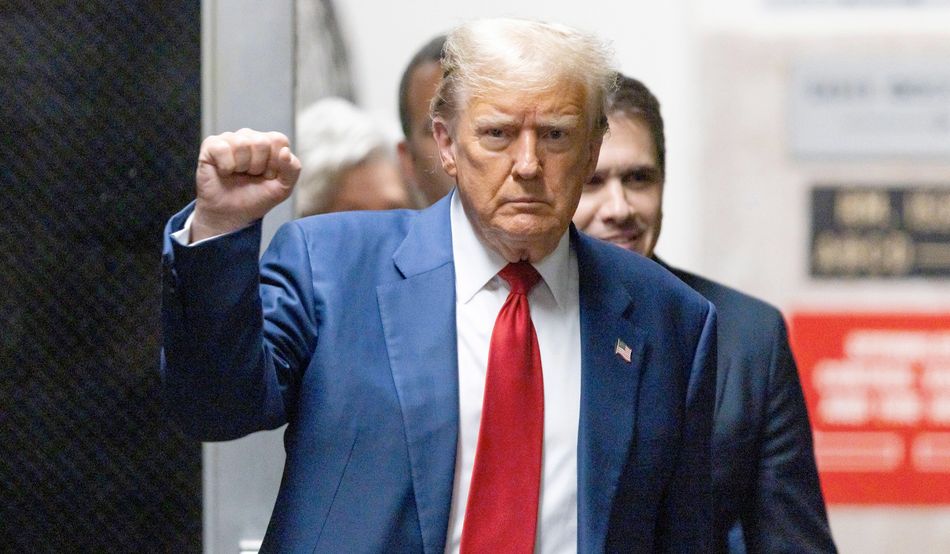Aristotle’s distinction between the rule of laws and the rule of men has left a long legacy. Laws, said the great sage, are considered, rational rules applying generally. The rule of a man, by comparison, is an invitation to government by discretion and ultimately to tyranny.
“He who would have the rule of a man adds an element of the beast,” he wrote, “for desire is a wild beast, and passion perverts the minds of rulers, even when they are the best of men. The law is reason unaffected by desire.”
There is no country in which this distinction is more important than the United States in the age of Donald Trump. Article II of the Constitution of the United States concentrates almost all civil and military power in the hands of the president. He—for the constitution assumes the president is a man—appoints all federal officers, subject in some cases to the approval of the Senate. Once appointed, these officers are the president’s agents, holding office at his pleasure and acting on his instructions. The president derives his powers directly from the Constitution and is not answerable to Congress except by way of impeachment.
All this is consistent with responsible government but only because the president is subject to law. The great case of Marbury v Madison (1803) is generally regarded as the foundation of American public law. Delivering the judgment of the Supreme Court, Chief Justice Marshall observed that “the government of the United States has been emphatically termed a government of laws, and not of men. It will certainly cease to deserve this high appellation if the laws furnish no remedy for the violation of a vested legal right.”
One can only speculate on what Marshall would have thought about the judgment of his successors in Trump v United States, which was handed down on 1st July. The court has held that Trump is immune from prosecution for criminal acts committed in the course of his official functions as president, even after he has left office. It was at pains to say that the issue should be addressed as a matter of principle and not just in light of the circumstances of the case. But it is fair to say that the circumstances of the case were a stiff test of their decision.
A federal grand jury in Washington DC had indicted Trump for conspiring to overturn the result of the 2020 presidential election. The indictment accused him of trying to do this by using allegations of election fraud which he knew to be groundless in order to get state officials to change Biden votes into Trump votes; by getting the Department of Justice to open sham criminal investigations into non-existent election frauds; by having bogus electoral college members put forward for certification by his vice president, Mike Pence; by pressuring Pence to reject the results from swing states that went for Biden; and finally by directing a violent mob of his supporters to the Capitol to bring pressure to bear on the vice president.
The grand jury had concluded that on the face of it these allegations were supported by the evidence. For the purposes of the appeal, it had to be assumed that they were correct, or at least that they might be. Most of them were matters of public record. The question was whether, even so, the prosecution should be barred.
The suggestion that Trump was immune from prosecution even if the allegations were true had been rejected with some indignation by the District Court for the District of Columbia and the Court of Appeals for the DC Circuit. If an ex-president is immune from criminal liability for trying to overthrow the Constitution and install an unelected intruder in the White House, one is bound to wonder what is left of the Constitution.
Before looking at how the Supreme Court arrived at its result, it helps to see how the law was generally understood before the judgment was handed down.
There is nothing about presidential immunity in the Constitution. Its framers knew how to include it, for they conferred some immunities on members of Congress. The omission of a comparable immunity for presidents is not of course conclusive, but what we know about the framers’ intentions suggests that it was deliberate.
They were English gentlemen well aware of the English legal maxim “The King can do no wrong”, and determined to have none of it. William Blackstone’s Commentaries on the Laws of England, then the most influential treatise on the common law on both sides of the Atlantic, had explained what this maxim meant: that the King was sovereign and, by definition, no institution can stand above a sovereign. He could not therefore be sued or prosecuted in his own courts (although there were other ways in which civil relief could be obtained). It also meant that by a legal fiction the King was incapable of acting unlawfully, because any unlawful act was to be imputed to his advisers, generally ministers answerable to parliament.
The framers of the Constitution chose a form of government to which none of these notions could apply. The United States was to be a republic belonging to the sovereign people. The president was not a sovereign but an agent of the state. The courts were not his courts, but a co-equal branch of the state. The imputation of wrongs to advisers and ministers, which was and is the cornerstone of English doctrine, made no sense in a constitution which had no equivalent of the English principle of ministerial responsibility. The United States has an executive president whose ministers and advisers are answerable to him and not to Congress. The danger of irresponsible government was allayed by the Constitution itself, which provided that it was to be “the supreme law of the land”. In 1879 the Supreme Court reviewed these points in Langford v United States and concluded that the maxim that the King can do no wrong had no place in the American system of government.
There was (and still is) a well-established rule, dating back to Marbury v Madison itself, that the courts will not question acts of the executive which lie within the discretion conferred on the president by the Constitution or by statute. This is sometimes described as an immunity. In reality, however, it only means that acts of the president in the exercise of a discretion conferred on him by law are lawful. They cannot therefore give rise to liability, civil or criminal.
There is also a principle dating back to the 1890s that all federal employees performing executive functions are immune from civil liability for damages arising from the performance of their duties. In Nixon v Fitzgerald (1982), the Supreme Court had applied this principle to any act of the president within the “outer perimeter” of his official functions. So Arthur Ernest Fitzgerald, who had been dismissed from the Air Force by President Nixon in retaliation for unwelcome evidence that he had given to a congressional subcommittee, was denied a remedy. The court’s reasoning was based partly on the extreme breadth of the president’s discretions in hiring and firing federal employees, partly on the public interest against distracting the president from constitutional duties, and partly on the court’s concern that without immunity he may perform his duties too cautiously for fear of provoking lawsuits.
The principle has its limits, however. In two later cases, Clinton v Jones (1997) and Trump v Vance (2020), the Supreme Court explained that the mere fact that litigation was liable to distract the president from his official functions was not enough. The real objection to civil litigation against the president was said to be that the distraction might lead to overcautious decision-making. President Clinton no doubt found it most distracting to have to answer Paula Jones’s allegation of sexual harassment, but that was irrelevant. He was not immune because, the alleged harassment having occurred long before he was elected, there was no question of overcautious decision-making.
Finally, there has for half a century been a convention that a president may not be criminally prosecuted during his term of office. The authority for it is rather thin. It consists of two opinions from the Office of Legal Counsel, part of the Department of Justice. The first was issued in 1973 when Nixon was being accused of obstructing the investigation of the Watergate break-in. The second was issued in 2000 when it was being alleged that Clinton had been party to a fraudulent property scheme in 1978, when he was attorney general of Arkansas. Both opinions argued that the prosecution or conviction of a sitting president was unconstitutional because it would distract him from his duties, especially if he was jailed. There is no judicial or other legal authority that says this, but the opinions matter because they are treated as binding within the Department of Justice. This means that they govern prosecution policy. Rightly or wrongly, the department does not prosecute sitting presidents.
One thing was clear. No one thought that presidents were immune from criminal liability after they had left office. Indeed, at Trump’s second impeachment trial his own lawyers accepted this. They argued that by throwing out the charges the Senate would not be putting him above the law, because an ex-president “is like any other citizen and can be tried in a court of law”.
This then was the background when the Supreme Court came to decide Trump v United States. The Court was divided. In a pattern which has unfortunately become routine, the majority comprised the six justices appointed by Republican presidents (subject to one reservation by Amy Coney Barrett), while the three justices appointed by Democratic presidents all dissented.
The majority judgment was delivered by Chief Justice John Roberts. His reasoning was that the Constitution confers enormous powers on the president so that he will be in a position to take bold and decisive action in the interests of the nation. For that reason, the Fitzgerald principle governing civil litigation against a current or former president should apply equally to criminal prosecutions. The threat of criminal prosecution, Roberts held, was at least as likely to give rise to distraction and overcautious decision-making as the threat of civil litigation. The role of the courts must therefore be limited to deciding whether the relevant act was done in the performance of the president’s official functions. If it was, then he was immune.
For the lower courts, the answer had been perfectly straightforward. The president has no constitutional or statutory authority to commit crimes. So criminal acts are by definition not part of his official functions.
In the Supreme Court, the majority thought that that was too simple. Courts, they said, cannot treat an act of the president as unofficial merely because some prosecutor has alleged that it violates the criminal law. But equally, courts cannot examine whether it actually did violate the criminal law. That might, for example, depend on the president’s motive for the act or whether he knew the facts which made it illegal. The courts, said the majority, could not be allowed to investigate that, for doing so would give rise to the very risk of distraction and overcautious decision-making which the immunity was designed to avoid. Thus the courts cannot be allowed to consider, for example, whether the president did the act because he had taken a bribe, although taking a bribe is by definition something that is done in the course of an official function. All that they can decide is whether the relevant act falls within a class of acts which presidents do in the course of their official functions.
The chief justice distinguished between those acts which fall within a president’s “core” functions, and other acts which fell within their “outer perimeter”. “Core” functions are those, such as hiring and firing federal employees or issuing pardons, where the law confers an unrestricted discretion on the president to do a class of acts that only he can do. In these cases, the inquiry stops there. The president is absolutely immune.
Cases falling within the “outer perimeter” of the president’s functions are those where the position is less clear. It may be difficult to know in what capacity the president was acting, or which if any of his many powers he was exercising. In these cases, the majority held that the president was “presumptively immune”. In other words, he is immune unless the prosecution can positively demonstrate that the relevant act did not belong to a class of acts which presidents can do, or perhaps that there was no danger of a distracting “intrusion” on his attention.
In plain language what this means is that because of the awesome powers and responsibilities of the president he must be allowed to do what he wants, without being unduly “distracted” by the thought that it may be a criminal offence.
The majority did not say and cannot possibly have thought that it was part of the official functions of the president to try to overturn a regular election result and occupy the White House through what would have amounted to a coup. But instead of looking at the nature and object of the conspiracy, their approach was to look separately at each of the things Trump is alleged to have done to further it.
The indictment alleged that Trump tried to get the Department of Justice to launch criminal investigations into non-existent election frauds. Discussing possible prosecutions with the department, said the majority, is the kind of thing that presidents do as part of their “core” constitutional duty to “take care that the laws be faithfully executed”. So those discussions are absolutely immune. Never mind that in this particular case the discussions were actually about defeating the laws by mounting sham investigations. No, the courts cannot be allowed to examine that sort of thing. So by a perverse irony, the fact that the president has a duty to see to the observance of the law becomes a reason why he cannot be prosecuted for breaking it himself.
The indictment alleged that Trump tried to get the Department of Justice to launch criminal investigations into non-existent election frauds. Discussing possible prosecutions with the department, said the majority, is the kind of thing that presidents do as part of their “core” constitutional duty to “take care that the laws be faithfully executed”. So those discussions are absolutely immune. Never mind that in this particular case the discussions were actually about defeating the laws by mounting sham investigations. No, the courts cannot be allowed to examine that sort of thing. So by a perverse irony, the fact that the president has a duty to see to the observance of the law becomes a reason why he cannot be prosecuted for breaking it himself.
Trump is said to have tried to get swing states to falsify their election returns to the Senate, and to induce the vice president to reject the election results of some states that voted for Biden. These were not “core” functions of the president, so they are only presumptively immune. Nonetheless, said the majority, discussing such matters with state authorities and the vice president may be a presidential function. Never mind that these particular discussions were about falsifying the result of the elections. The courts cannot be allowed to look into that.
No one thought that presidents were immune from criminal liability after they had left office
The majority’s most remarkable observations concern Trump’s notorious tweets and public speech on 6th January 2021, in which he urged his supporters to head for the Capitol to pressure Vice President Pence. The president, they declared, “possesses extraordinary power to speak to his fellow citizens”. So if the court finds that Trump was tweeting and speaking as president and not, say, as a party leader or candidate, then what he said was by its very nature immune. Never mind if the “fellow citizens” whom he was addressing were an ugly mob whom he was inviting to invade the Capitol and threaten legislators with violence. The courts cannot be allowed to look into that either.
There are a number of problems about all this, apart from the absurdity of the result.
One is that the distinction between the kind of power the president was exercising and the way that he was exercising it is incoherent. Often, the only way that you can decide whether an act of the president was done in the course of his official functions is to enquire why and how he did it. But that is the one thing that the judgment stops the courts from doing.
However, the fundamental difficulty with the reasoning is that there is no analogy between the risk of civil litigation and the risk of criminal prosecution. Civil litigation is designed to vindicate a private right of the plaintiff. Criminal prosecutions are an entirely different matter. They are brought by the state to vindicate a public right—namely, the right to have the Constitution respected and the criminal law observed. The law does sometimes override private rights in the public interest. But the enforcement of the criminal law against anyone, however mighty, and the protection of the Constitution against a coup are both public interests of an altogether higher order. Overriding them raises issues which go to the root of the Constitution.
The scale of the risk is also very different. The United States is a litigious society. Anyone with a grudge can get a lawyer on a contingency fee to bring a civil complaint based on their own perhaps fanciful version of the facts. This is not true of criminal prosecutions. Prosecutors have important ethical obligations. They are subject to administrative and professional disciplinary codes. They must have reasonable and probable cause to believe that a person has committed a crime before proceeding. Felonies are the most serious category of crimes, and in the federal system and most states a prosecutor must persuade a grand jury that there is sufficient evidence on each count to justify a prosecution. In the entire history of the United States, no serving or former president has ever been indicted for criminal conduct in office until now, although Nixon could have been if his successor had not pardoned him.
One might think that if there is reasonable and probable cause to believe a president has committed crimes, some investigation would be in order, however distracting, so that the judicial branch of the state can perform its own duty to apply the law. However, the nub of the majority’s reasoning is not the issue of distraction. It is their apparent concern that without immunity presidents may be overcautious in their decisions. What is the basis for this concern? The short answer is that there is none. No empirical evidence or historical experience was cited, and the suggestion is both factually implausible and conceptually bizarre.
It is factually implausible because the risk of criminal prosecution does not seem to have led to overcautious decision-making by Trump himself or by any of his 44 predecessors, even though it had always previously been assumed that presidents were exposed to prosecution for their crimes like anyone else.
It is conceptually bizarre because when the judges talk of overcautious decision-making, they must mean an approach to decision-making which would be unduly influenced by the need to take extra care to avoid prosecution. But there is a much simpler way to avoid prosecution: refraining from committing crimes. Unlike most civil liabilities, criminal liability almost always requires a guilty mind. There has to be proof of knowledge and intent. Presidents do not commit felonies by accident or without realising what they are doing. As for the risk of baseless accusations of criminality, if that really is a problem then there is no amount of caution in decision-making that can avoid it.
The Supreme Court majority objected with some asperity to the suggestion by the dissenters that their judgment put the president above the law. But what other construction can be put upon their words? If there is no remedy against the president, then there is no law binding on him. The danger that presidents will change their approach to decision-making in order to avoid criminal liability seems remote. The danger that some presidents, freed from the prospect of criminal liability, will more readily turn to crime is surely much greater.
The Supreme Court has always been a very political court and usually a very conservative one. In Dredd Scott v Sandford (1857), the Court notoriously held that African Americans could not be citizens, contributing to the tensions that ultimately provoked the civil war. After that war, it conducted a rearguard action against the constitutional amendments and congressional acts which sought to outlaw discrimination against African Americans. During the so-called Lochner era between 1897 and 1937, it repeatedly struck down employment protection laws in the name of freedom of contract. It obstructed Franklin D Roosevelt’s New Deal projects designed to create employment during the Depression of the 1930s.
The Court’s approach changed after the Second World War. The turning point was the appointment of Earl Warren as chief justice in 1953. A new generation of justices stood for a liberal agenda on racial segregation, civil rights and moral issues such as abortion. Some of their decisions were politically controversial. In particular, the decision of the Court in Roe v Wade (1973), recognising a constitutional right to abortion, polarised American opinion. It led directly to the adoption as part of the Republican party’s platform of a policy of packing the Court with justices who would reverse the liberal tide. As a result, presidential elections became a contest for the right to appoint sufficiently partisan justices to the Supreme Court. The Court became political in a new and more dangerous sense.
Before the 1990s, presidents had not always appointed justices who agreed with their own political outlook. Democrats sometimes appointed conservatives, and Republicans sometimes appointed liberals. Attempts to pack the Court usually failed, because even politically sympathetic justices could be resolutely independent-minded after their appointment. Dwight Eisenhower appointed Earl Warren, a former Republican governor of California, in order to consolidate a conservative majority on the Court, and was grievously disappointed by the result. “I made two mistakes,” he famously declared some years later, “and both of them are sitting on the Supreme Court.” (The other was Justice William Brennan.)
Recent Republican presidents have learned from Eisenhower’s mistakes. The Federalist Society, a conservative legal pressure group founded in 1982, grooms convinced conservative lawyers from a young age for jobs in the federal judiciary. All six justices of the Court’s current conservative majority were either members of or closely associated with the Society. So were 43 out of Trump’s 51 nominees to federal circuit courts of appeal. None of them has done a Warren. And since they are appointed for life, they will be around to preserve their appointer’s legacy long after he has left office.
The position is aggravated by partisanship on the Senate Judiciary Committee, which must confirm appointments. Republican majorities on the committee delayed the confirmation hearings for Merrick Garland, Barack Obama’s nominee for his last Supreme Court appointment, until his term ended so that Obama’s Republican successor could fill the vacancy instead. They then accelerated the hearing of Coney Barrett, Trump’s last appointment, so as to get it confirmed before he left office.
The conservative majority on the Court does not always side with Trump. In Trump v Vance, a rare bipartisan decision, they rejected Trump’s argument that as president he was immune from having to produce documents about his tax affairs in response to a New York subpoena. All of Trump’s appointees signed up to that. But the conservative majority has consistently given the force of law to Republican positions on, for example, abortion, gun control, election expenses, discriminatory voting rules, gerrymandering and the powers of statutory executive agencies such as the Environmental Protection Agency. As a result, the Court’s legitimacy has been gravely undermined, and its public approval rating has collapsed from 80 per cent in the 1990s to less than 50 per cent now.
This is a more serious problem in the United States than it would be in any other country. Congress is polarised, dysfunctional and gridlocked. Filibusters make it difficult to get controversial legislation through. This often leaves the Supreme Court as the only institution that can change the law on contentious issues. When the Supreme Court changes the law on constitutional grounds there is no democratic way to undo it. Their rulings determine what the Constitution means until the crack of doom, because the Constitution is practically incapable of amendment without bipartisan support. It needs a two-thirds vote in each house of Congress and ratification by three-quarters of the states. This is a problem almost unique among the world’s constitutions.
Presidents do not commit felonies by accident or without realising what they’re doing
The decision in Trump v United States is merely the most recent and extreme symptom of a profound constitutional disorder in the affairs of the United States. The country’s constitution is the oldest written one in the world, but it is a fair weather instrument. The United States is fortunate in having enjoyed a great deal of fair weather in the course of its history. But that may now be coming to an end.
The elaborate system of checks and balances can work only if there is common ground across the political spectrum that the end does not always justify the means. There has to be a culture in which politicians regard it as more important to make the Constitution work in the interest of all parties than for any one party to get its way by hook or by crook. The Republican Party’s sense of political entitlement, its ruthless constitutional obstructiveness and its irrational rage against the Democratic presidents Clinton and Obama have junked the political culture that made the Constitution workable.
Biden’s proposal that the president should appoint one justice every two years to sit for a limited term of eighteen years is a sensible start, but the Democrats would need an electoral landslide for it to have any chance of getting through Congress. His proposal to amend the Constitution to make presidents answerable for their crimes is at once essential and impossible. The United States has never stood in greater need of impartial constitutional arbiters in its highest court, and has never been further from getting them.














